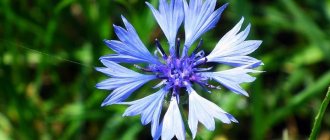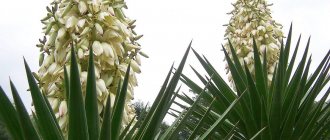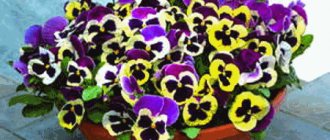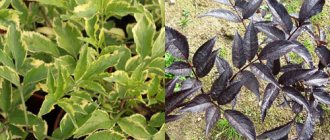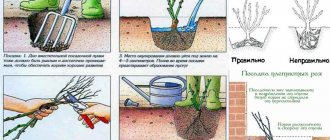The beauty of most flowers is mesmerizing, and many flowers are also easy to recognize among other flowering plants even for inexperienced gardeners. Forget-me-not is such a flower. The name of this plant consists of two words of Greek origin, meaning “mouse” and “ear”. This is due to the fact that certain types of forget-me-nots have dense pubescence of short hairs on their leaves, which is why they resemble mouse ears.
The flower belongs to the borage family; to this day it continues to be used in folk medicine and helps in the treatment of lung diseases. The flowering plant has about 50 species, which in most cases are used as garden decoration in landscape design. A huge number of garden varieties are cultivars and hybrids that, if grown from seed, retain their characteristics and qualities.
The forget-me-not flower (photo) is quite unpretentious in care and maintenance, which makes it even more attractive for flower growers and gardeners , and especially for beginners. For this reason, the plant is distributed throughout the world: not only in Russia, but also in Europe.
This article will discuss a description of forget-me-nots, its popular types, features of cultivation, care and reproduction.
Description of the flower
Grows mainly in damp areas. Its habitat is Europe and Asia; the plant can also be found in South Africa, America, New Zealand and Australia. In this section you will learn what a forget-me-not flower looks like.
Forget-me-not is an annual or perennial plant (it depends on the variety). The stems are branched, similar to a small shrub, reaching a height of 40 cm. However, there are species with taller creeping flowers. Depending on the type of flower, the leaves can be linear-lanceolate, sessile, lanceolate, or spatulate. Foliage color can vary from bright green to grayish green. The inflorescence is collected from several blue flowers with a yellow center. Also, the color of the flower can be pink or white.
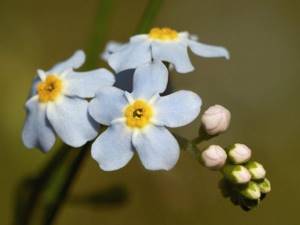
The flowering period begins in May and lasts until mid-June; after flowering ends, the fruit appears - a nut. One gram can contain up to 2000 seeds, which can be stored without damage to germination for up to 3 years. The seeds are black in color and ovoid in shape. The first shoots appear a few weeks after sowing.
Three “main” forget-me-nots
PLACE: Forget-me-not, forget-me-not / Myosotis
All forget-me-nots are short - 10-40 cm. The flowers are most often blue with a yellow eye, but pink and white are also found. They bloom from May to mid-June.
In most European languages, the name of forget-me-not has the same meaning: in English it sounds like forget-me-not, in German Vergissmeinnicht, in Polish Niezapominajki, in Spanish No me olvidesu. Even Korean, Chinese and Japanese have corresponding analogues.
The most commonly grown garden hybrid is the alpine forget-me-not. It is on its basis that numerous garden cultivars have been bred.
Popular varieties of garden forget-me-not with blue and blue flowers:
forget-me-not Miro - height 15 cm, light blue flowers;
Forget-me-not Victoria - bright blue flowers;
Forget-me-not Blue Ball - 15 cm high with bright blue flowers;
Forget-me-not Indigo Compacta - up to 25 cm in height, blooms with bright blue flowers.
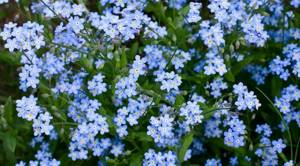
Forget-me-nots blooming
Forget-me-not care
To grow forget-me-nots, it is best to choose places in light shade. Forget-me-not prefers moist, well-fertilized soil. It tolerates replanting well throughout the growing season and even during the flowering period.
Self-seeding appears in mid-July, and by August a dense compact bush has already formed.
PLACE: Brunnera, forget-me-not, Caucasian forget-me-not / Brunnera
The genus is named after the Swiss botanist Samuel Brunner, who discovered and described the plant. The genus includes only three species, two of which are grown in gardens: large-leaved brunnera (Brunnera macrophylla) and Siberian brunnera (Brunnera sibirica). Both brunners bloom with blue flowers collected in airy inflorescences. Brunners look great in large areas and are suitable for creating spring decorative groups and shady garden compositions.
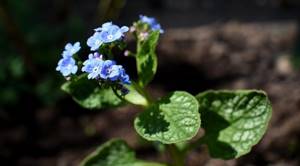
Nowadays the Jack Frost variety is very popular; its leaves are almost white, only the veins are green and there is a narrow stripe along the edge of the leaf.
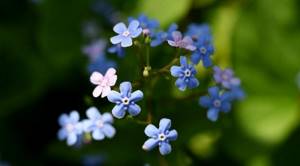
Siberian Brunnera (Brunnera sibirica) is a long-rhizome perennial, up to 60 cm high, forms a dense thicket. The inflorescence is a paniculate curl of bright blue flowers.
Brunnera care
Brunnera macrophylla and Brunnera sibirica do not require the use of complex agrotechnical techniques when growing; they are easy to plant and grow, in addition, they winter well in the conditions of Central Russia.

In the photo: Brunnera macrophylla Jack Frost
Brunnera macrophylla is suitable for flower beds located in the shade and under the canopy of trees. Its bush can please you for 10-15 years without transplanting in one place.
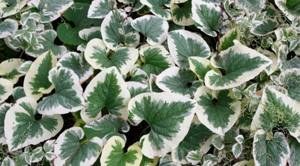
In the photo: Brunnera macrophylla Variegata
Brunnera sibirica forms thickets and is quite aggressive, suitable for growing in large areas in parks.
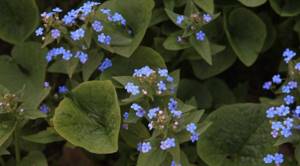
In the photo: Brunnera sibirica
3rd PLACE: Omphalodes, umbilical cord / Omphalodes
Another beautiful spring plant is omphalodes, or as it is also called navelworm, also known as the creeping forget-me-not.
The genus Omphalodes has about 25 species; Omphalodes verna has been grown in Europe since the 17th century. This beautiful spring-flowering plant grows and blooms well in central Russia. It blooms from early May to mid-June, while the flowers themselves are the largest of the “forget-me-nots”.
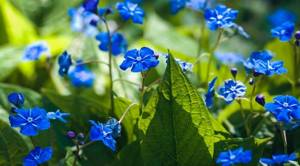
Omphalodes spring blooms in the garden.
Omphalodes Care
Omphalodes vernalis is also a shade plant; it is perfect for creating a decorative and durable ground cover.
Prefers soils that are rich, loose, and without excessive moisture. Propagated by separating daughter rosettes in late summer–early autumn.
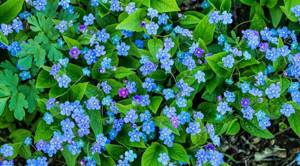
Omphalodes spring blooms in the garden.
Popular types
There are a huge variety of forget-me-not varieties (about 50 species), depending on the place of growth. A large number of flower species are known not only in America, Africa and Australia, but also in Russia; the most popular varieties will be discussed further.
Alpine forget-me-not (Myosotis alpestris)
This species can be found in the Alps, Carpathians and the Caucasus. The height of the stems reaches 5-15 cm, the root system is short. The leaves have a gray-green color. The flowers are dark blue. Flowering lasts a long time - about seven weeks. It is one of the few species that prefer to grow in a sunny area.
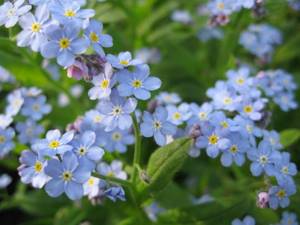
There are several breeding varieties:
- Miro and Victoria - the flowers have a light blue tint. Miro's stem reaches a height of 15 cm, while Victoria's is twice as large.
- Carmen King - the flowers of this species have a dark pink hue, the stem reaches 20 cm in length.
- Compinidi, Music and Blauer Korb are varieties whose flowers are dark blue.
- Indigo and Blue Ball are considered low varieties, the stem reaches a height of 15 cm, the color of the flowers is blue.
Forget-me-not (Myosotis palustris)
Refers to perennial plants. The stems have four sides, branch well, reaching up to 30 cm in height. The foliage is large - reaches approximately 8 cm in length, 2 cm in width, and has a bright green color .
When do forget-me-nots of this species bloom? Flowering begins in May and continues until September. The flowers are pink or blue. They are relatively large in size, initially found in strong curls, which stretch out over time.

It grows mainly on the banks of rivers, swamps, and lakes, as it loves moist soil. Habitat is Siberia, Mongolia, Central Europe, Transcaucasia, and the Balkans.
In this species, several varieties can be distinguished. The most spectacular variety is the Thuringen variety, which has dark blue flowers. A variety of Semperflorens has also been developed, the flowers of which are bright blue in color and have a yellow core.
Forget-me-not (Myosotis czekanowski)
This type of flower is listed in the Red Book of Russia. It grows only on the left bank of the Talagan River (Kharaulakh Mountains) and in the Olenek-Lena interfluve, as well as in the northern part of the Verkhoyansk Range. Finding this flowering plant is quite difficult.
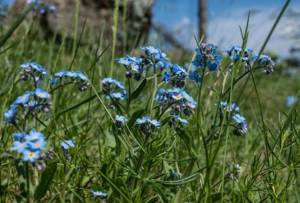
Forest forget-me-not (Myosotis sylvatica)
It is a representative of perennial plants, prefers to grow in moist and shaded places. Grows in Europe and the Carpathians. The height of the stem grows up to 30 cm in height. The leaves have an elongated oval shape and a soft green color. Inflorescences are light blue. It has a long flowering period.
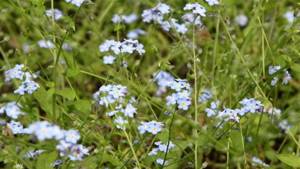
Forget-me-not (Myosotis arvensis)
Used as a medicinal plant. The stem is quite low, the flowers are blue and small in size (up to 0.5 cm in diameter). The flowering period begins in May and continues until late autumn. Grows in North Africa, Asia, Siberia and the Canary Islands.
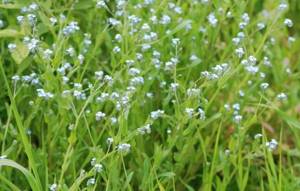
Reshteiner's no-brainer (Vyosotis Rehsteineri)
It is a type of forget-me-not that creeps along the ground and forms a light blue flower carpet. It begins to bloom in April and continues until May. It is a perennial plant that requires virtually no special care and maintenance.

There are also a large number of domesticated species of forget-me-nots that can decorate your garden plot.
Perennial species and varieties of forget-me-nots
Plants that have one root system and develop for more than two years are considered to be perennial. Unlike shrubs and trees, the stem of forget-me-nots does not become woody. It is believed that such flowers feel more comfortable on poor soils.
Did you know? Translated from Greek, the name forget-me-not means “mouse ears.” It was so nicknamed because of the specific shape of the leaves, which resemble the ears of these rodents.
Bolotnaya
The species is most often used in gardens and is ideal for cultivation in the middle zone. It is considered a short-lived perennial plant. The marsh variety "Turingen" is one of the most common. It, like the whole species, is distinguished by blue flowers. In the wild, it is often found near ponds and swamps. In this regard, it is often used by landscape designers to design artificial lakes and ponds. It grows successfully where a stream flows.
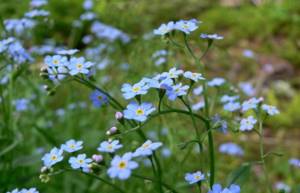
This variety produces the largest flowers among forget-me-nots. They reach a diameter of 1.2 cm. The stem is usually covered with small fibers. Its maximum length is up to 30 cm. The leaves of the plant are painted in a bright light green color. Their length is 8 cm and width is 2 cm. The inflorescences begin to bloom in May. The last petals fall only in October. It blooms profusely as it constantly forms new shoots.
Alpine garden
Garden alpine forget-me-not, also called hybrid, was obtained by hybridizing alpine forget-me-not. The bushes grow up to 30 cm in height. The leaves of this species are large and the flowers are colored in different shades depending on the variety.
Planting a flower
Planting seeds
For those who want to achieve forget-me-not flowering in the spring, the seeds must be sown in the spring. To do this, you need to take a container in which there will be a hole for water, and fill it with a substrate consisting of sand and turf soil (2:1). Before sowing, the planting container is treated with a solution of potassium permanganate. Next, the seeds should be immersed in lightly salted water, which will eliminate empty seeds. Good seeds are washed under clean water and left to dry.
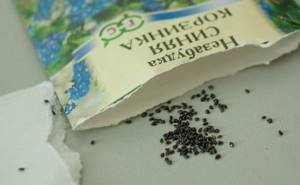
It is necessary to sow exclusively on the surface of the soil, lightly crushing it with earth. Then the container is covered with paper and the first shoots are awaited. The first shoots should emerge in about a week. After the first leaves appear on the plant, small forget-me-nots dive into the container, the flower is placed at intervals of at least 3 cm from each other. Upon completion of all stages, the containers with the plants should be transferred to a cold greenhouse until spring. In March, the containers must be moved to a warm place. And already at the end of April the flower can be planted directly into the ground . Buds may appear on the forget-me-not at this time.
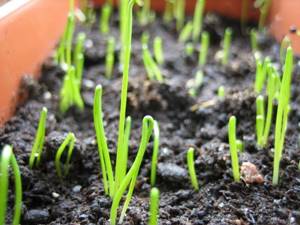
There is another method of sowing seeds - planting them in the ground in open areas. This procedure should be performed in July. Before sowing, it is necessary to add fertilizers to the soil - humus and peat, and also add nitrophoska. It is necessary to make furrows in the soil into which the seeds will be placed, and then sprinkle them with river sand.
These beautiful plants can delight your eyes for a long time with their flowering and during cutting. Cut forget-me-nots can last in a vase, provided the water is clean and cold, for almost a month. It is noteworthy that withered flowers will be replaced by new, blossoming buds.
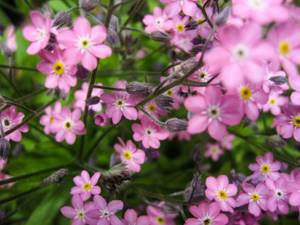
Planting seedlings and cuttings
Before planting cuttings or seedlings, the soil must be prepared - thoroughly dug, loosened, fertilized and moistened. Then make planting holes and place the seedlings there - the forget-me-not will certainly take root.

Popular varieties of forest forget-me-not
The genus of this plant includes over 60 species, of which about 30 are found in our country.
Let's look at the most common of them:
- Alpine. It has a height of 20 to 30 cm. The bush is short and dense, the flowers are from dark blue to light blue. It fades completely in the sun and grows only in the shade.
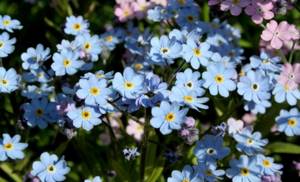
- Hybrid. Bred artificially. It has the shape of a ball, the height of which is about 14–18 cm. The color of the flowers is bright azure or dark blue.
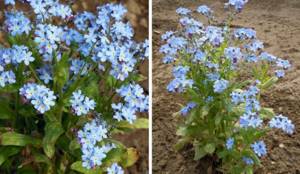
- Bolotnaya. The height reaches 30 cm. A distinctive feature of the plant is its shoots, which branch strongly and produce many adventitious roots if the stems lie on the soil surface. It blooms for a very long time - from late spring to early autumn. The flowers have a dark blue tint.

- Arranged-flowered. Height - up to 35 cm, spreading form of the bush, characterized by abundant flowering. Flowers are bright blue.

- Chekanovsky. This representative of the Borachkov family is listed in the Red Book of Russia. The height of the plant is up to 20 cm, the shoots are tightly packed relative to each other. The flower is light blue. It grows in the rocky mountain landscapes of the northern regions of our country.
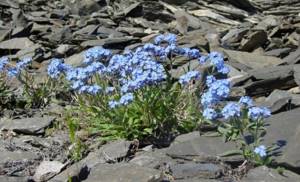
Features of care
- Forget-me-not is a frost-resistant plant and prefers to grow in the shade.
- Flowers grow well in moist meadow, sandy-clay or clay soil. Thus, watering should be done once every three weeks . The main thing is not to overdo it, because the plant can wither from excessive moisture. It is not recommended to plant the plant in soil that is too nutritious, as this will lead to rapid growth and poor flowering. The soil, which is poor in nutrients, is also not suitable for the plant.
- There is no need for weeding ; on the contrary, this procedure can only harm the plant.
- Fertilizer must be applied to the soil at least once a month (this can be mineral and organic fertilizers, from which you can prepare a mixture: dilute 1 teaspoon of potassium sulfate, urea and nitrophoska in 10 liters of water).
- If you want to prolong the flowering of forget-me-nots, then you should not flood it, but provide the plant with access to indirect sunlight. This will make the color of the flowers richer and brighter.
- This flower can easily tolerate transplants and quickly adapt to a new place.
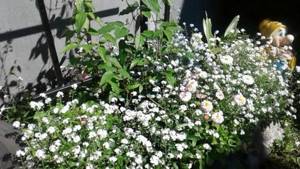
Note! Failure to follow the rules of care and maintenance of the flower (excess or lack of moisture, planting in a sunny place) can lead to rotting of the roots, drying out of the leaves and wilting of the flowers.
Reproduction
You can propagate the forget-me-not flower in several ways:
- Seeds . The process of checking seeds and planting them in the ground (both open and in containers) was described above.
- Dividing bushes . This is a fairly effective method, since the flower easily tolerates transplantation. Transplantation can be carried out at any time of the year. Due to the strong root system, the plant will quickly and easily take root. As it ripens, the forget-me-not produces a large number of seeds, which, falling off, self-propagate. Thus, new shoots sprout near the already faded bush, which can be used for replanting.
- By cuttings . Varietal forget-me-nots are recommended to be propagated in this way. The process occurs as follows: in June it is necessary to cut off the green apical cuttings, which have already reached a length of 4-5 cm. Then they are planted together with germinated seedlings. Forget-me-nots grown in this way will be able to bloom this season, but the flowering will be short and weak.
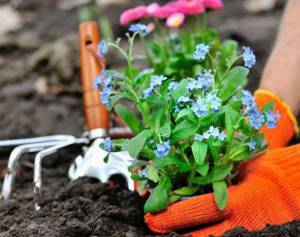
How to grow forget-me-nots in the garden
For planting forget-me-nots, seeds, seedlings, cuttings and dividing the bush are used as the main methods of propagation.
The plant has vitality: it responds well to transplants and quickly takes root in a new place.
Planting seeds
It is recommended to plant seeds directly on the site at the end of summer - it is simple and convenient. The seed material is pre-seasoned in salt water. Only seeds that have settled to the bottom are suitable for use. Soil preparation includes digging with peat and humus. After this, straighten the soil with a rake and moisten it. Place the seeds in holes or shallow grooves. It is necessary to maintain an interval between grains of about 10 cm. Sprinkle with a thin layer of sand. The area will turn green after 2-3 weeks. After the formation of several leaves is completed, the plants are thinned out and planted. They are moved to a permanent place in August or early September, and next year the forget-me-nots will delight you with flowering.
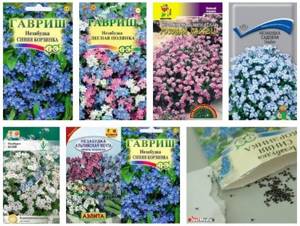
Seeds
Seedling method
Seedlings are planted in a greenhouse or in containers in October-November, then after six months the plants will bloom. In light soil, seeds are planted very finely or sprinkled. For germination, shade, moderate humidity and drainage are sufficient. Diving is carried out after the formation of 2-3 leaves. In winter, young forget-me-nots are kept cool, and in March they are transferred to a warm room. By the end of March or April, the seedlings are ready to be transplanted into the flower garden, and in May they will produce color.
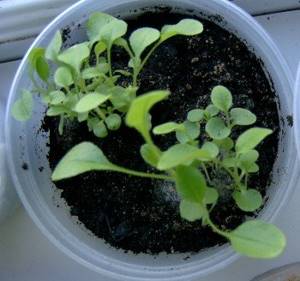
Seedling
Cuttings and dividing the bush
It is convenient to propagate varietal forget-me-nots by cuttings. Cuttings are cut from the top on warm June days. A length of 4-5 cm is sufficient. For rooting, they can be placed in water or in a container with substrate and covered with film. They are planted on the plot in early autumn, just like germinated seedlings.
Dividing the bush is very effective and can be done at any time, even during flowering. The rosettes are easily separated from each other and quickly take root after planting. Due to the structural features of the root system, small roots are not injured when separated.
Forget-me-not is prone to self-seeding. The fallen seeds soon sprout around the mother bush. Young bushes can be planted in a new area.
Diseases and pests
If the rules for caring for forget-me-nots are not followed, the plant will begin to get sick and will be attacked by harmful insects.
Downy mildew
The manifestation of this disease is white spots on the top of the leaves, and a dirty white coating on the bottom .
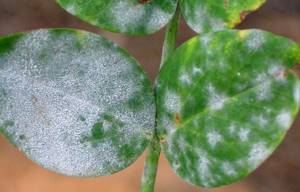
To prevent the occurrence of the disease, it is necessary to reduce the level of air humidity in winter gardens and greenhouses, which will prevent dew from falling at night, and also to spray the plant infrequently. If mass planting is carried out, the room must be well ventilated. If the plant does become sick, the affected areas should be removed. In the early stages of the disease in mass plantings, it is recommended to spray the plants with Previkur or Copper Oxychloride.
Powdery mildew
Signs of the disease are the appearance of a white powdery coating on all sides of the leaf , on the petioles, and later on the flowers. Under the covering of tissue, the plants have a brown color.
If plant damage has just begun, you can use Alirin-B, Fitosporin-M. If the lesion covers the entire plant, it should be treated with the following preparations: Pure Flower, Strobi, Topaz.
Gray rot
It manifests itself as damage to plant tissues, which become watery and soft. If the air humidity is high, a gray coating may form.
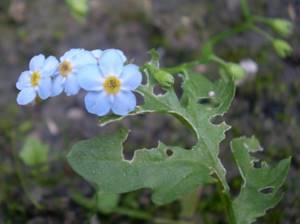
To overcome the disease, you should cut off old leaves and all parts of the plant that have begun to die . It is also worth lowering the air humidity in winter. The plant should be kept in a dry room, it should not be sprayed, and care must be taken to prevent dew from appearing.
Similar articles:
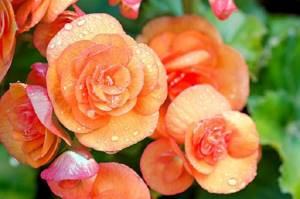
Garden begonia - growing and caring for the plant
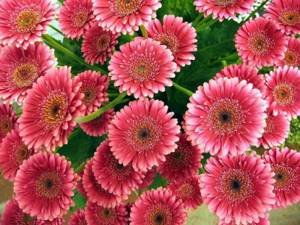
Growing gerberas in the garden - step-by-step instructions with...
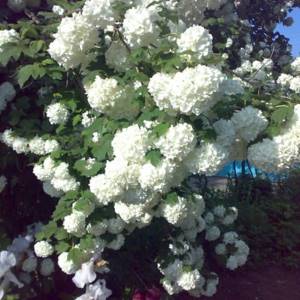
Bride flower (Euphorbia marginata) – cultivation and…
How to use in landscape design?
Forget-me-not will be an excellent option for decorating a flower bed, flower garden or balcony . Many varieties of flowers can be grown at home. When choosing a place to plant forget-me-nots, you should take into account the type and variety of this plant; the marsh one will perfectly decorate an artificial pond, the garden one will decorate a flowerbed, the alpine one will look great among the stones.
Forget-me-not goes well with tulips, lilies of the valley, and daffodils . Daisies and pansies will also look great in a flower bed next to it.
You can replace forget-me-nots when it comes to selecting plants for shaded and moderately humid areas of the garden:
- lungwort,
- small bulbous, daffodils, crocuses,
- Chiostophyllum.
Below are photos of flowers in the flowerbed:






